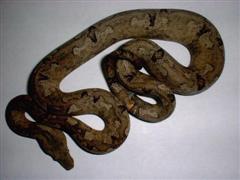Boa - Papuan Tree
New Guinea Tree Boa, Pacific Tree Boa Scientific Name: Candoia c carinata
Mon, 28th April, 2025 - 11:49 am GMT
Sponsor Ads:

Alternative Name
New Guinea Tree Boa, Pacific Tree Boa Scientific Name: Candoia c carinataBasic Info
Papuan or New Guinea Tree Boas have rounded, sausage-shaped bodies. Their scales are keeled. The head is triangulated and has an upturned scale at the tip of the nose. Papuan Tree Boas usually have tan, gray, or black basic colorations, although some may have pink, yellow, orange, or red variations. Usually, there are bands or blotches of another color atop the base color, leaving a visually pleasing pattern. The tails are rather short, though strong. By maturity, they usually reach lengths between three and five feet (one and a half meters maximum). Generally, males are smaller than females.
Health
Papuan Tree Boas should usually have vertically oriented enclosures that include branches on which these snakes can bask or climb. A large, shallow water bowl should be present for soaking. They should be kept at 80 - 85 degrees during the day, witha 10 degree nightime temperature drop. Papuan Tree Boas are usually fed rodents of an appropriate size. Breeding Breeding Papuan Tree Boas is most easily achieved after the snakes have been cooled for four to six weeks. Although daytime temperatures can remain normal during this period, the nighttime drop should increase from about a ten-degree drop down into the upper 60 degree Fahrenheit range. Generally, several males combined with several females tend to ensure a better chance of pregnancy. Color mating may also be achieved. Generally, two high color contrast parents will produce offspring with similarly high contrast patterning, while low contrast parents will probably produce low contrast offspring. After a gestation period lasting seven to nine months, up to 60 young are born. Neonates are usually not fed for about three weeks after birth, when they can be started on pinkie mice. They are usually more apt to feed on lizards or treefrogs. You may also wish to try scenting pinkie mice to induce young Papuan Tree Boas to feedHabitat
Found in the south Pacific, usually on the Solomon Islands or in IndonesiaBehavior
The beautiful Papuan Tree Boa is an endangered reptile that is often offered in the pet trade, so it is important to obtain captive bred Papuan Tree Boas to help preserve wild populations. These snakes are known for their docile temperaments, and the come in wide range of coloration and patterning. Known for their docility, Papuan Tree Boas, especially captive born specimens, tend to be easier to tame than many snakes. They are nocturnal and arboreal in the wild, and are not particularly active. In captivity, if a Papuan Tree Boa moves, it is usually only from one resting spot to another without any waste of energy or time. Because of this apparent reluctance to expend much energy, Papuan Tree Boas may not make the most interesting captives, movement wise. As a whole, the ease of taming and the beauty of coloration make these snakes desirable and lovely pets.Origin
New GuineaHistory
Papuan Tree Boas are only found in the south Pacific, usually on the Solomon Islands or in Indonesia. They are also sometimes called Ground Boas, despite their arboreal habits. Papuan Tree Boas have not recently been exported from their native homes, as they are listed as CITES type II. This means that they are endangered, probably due to loss of habitat and exportation for the pet trade.Common Foods
N/ASponsor Ads:
Cavanaugh's Postulate: All kookies are not in a jar.
Boa - Papuan Tree
Coded by: BGID® | ALL RIGHTS RESERVED Copyright © 2000-2025
Disclaimer | Privacy | Report Errors / Contact | Credits


 Preparing For China. China is growing their military. China Military Technology - can it keep up with the US?
Preparing For China. China is growing their military. China Military Technology - can it keep up with the US?  versus
versus 

 versus
versus 
 This Thread is about the North Korean Military itself - the kind of army, navy, and air force they have.
This Thread is about the North Korean Military itself - the kind of army, navy, and air force they have. 
 versus
versus 
 versus
versus  versus
versus